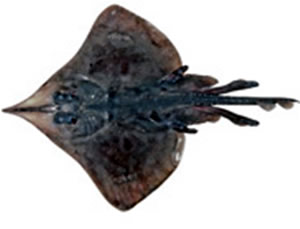
The Maugean Skate Zearaja maugeana, a new species from Bathurst and Macquarie Harbours in Tasmania. Lsted as Endangered by the IUCN Red List
Australian scientists have completed an ambitious 18-month project to name and describe more than 100 new species of sharks and rays.
Conducted by scientists working under the auspices of CSIRO's Wealth From Oceans National Research Flagship, the project named a third of Australia's – and about a tenth of the world's – shark and ray species.
Team leader, CSIRO's Dr Peter Last, says analysis of DNA sequences was used to clarify the identity of closely related species.
"Additional taxonomic information like this is critical to managing sharks and rays, which reproduce relatively slowly and are extremely vulnerable to over-fishing and other human impacts," he says. "Their populations are also sensitive to small-scale events and can be an indicator of environmental change."
CSIRO's Dr William White says sharks and rays also play a vital ecosystem role as apex predators. "Take them away and what does it mean for the rest of the ecosystem?" Dr White says. "We can't understand possible implications unless we know what species we're dealing with."
The new species include:
- The endemic, Northern Freshwater Whipray and the Northern River Shark, which grow to over two metres in length, and are among the largest freshwater animals in Australia. Until recently these were confused with similar marine species.
- The Endangered Maugean Skate which has an extremely narrow distribution. It is closely related Gondwanan ancestor which lived off southern Australia some 80 million years ago, and the present day species clings to life at the south-western tip of Tasmania.
- A Critically Endangered gulper shark, the Southern Dogfish, which is endemic to the continental slope off southern Australia. It has suffered severe population declines in the past few decades.
A workshop focusing on the project's findings will be held at Sydney's Australian Museum on 22 September during the 2nd Annual Meeting of the Oceania Chondrichthyan Society. Involving some of the world's leading experts in the field, the WWF-Australia-sponsored workshop also will assess priority areas of future research and management of sharks in Australian waters.
